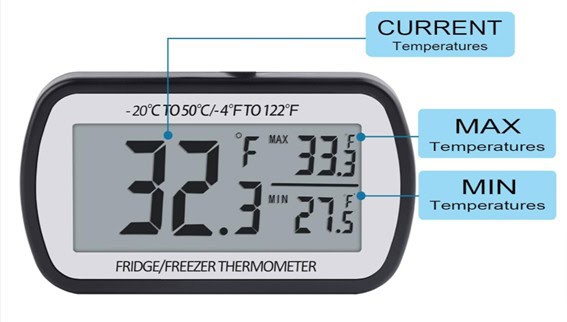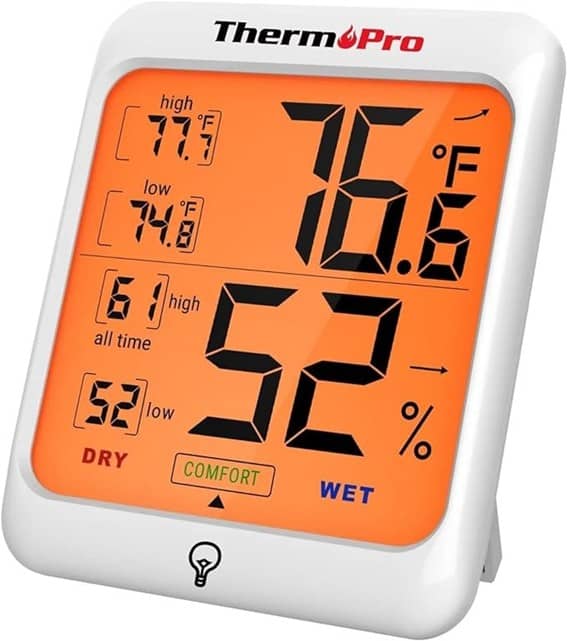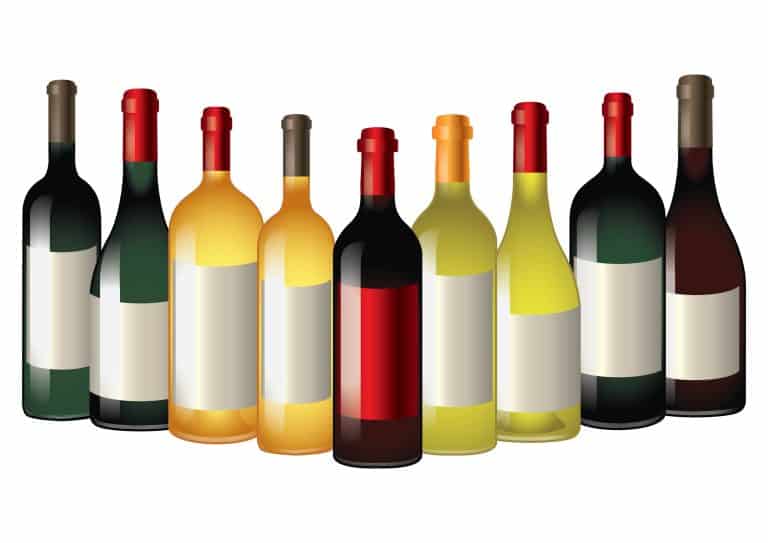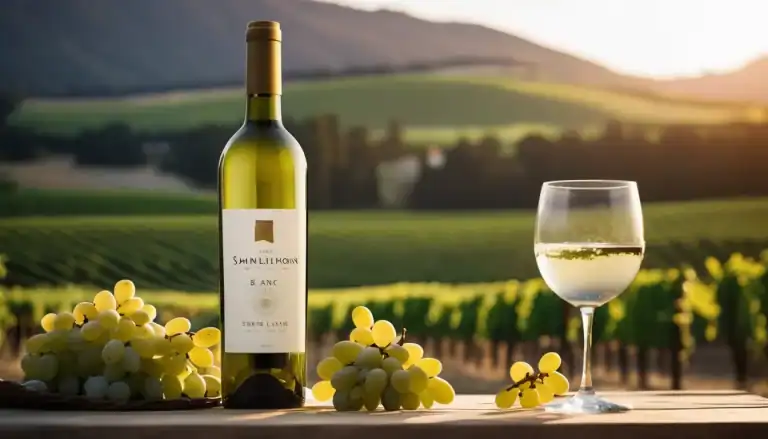Did you know that less than 1% of all wines produced globally are meant to be aged?
Yet, when done correctly, wine aging can transform an ordinary bottle into an extraordinary experience worth thousands of dollars! As a wine enthusiast and collector, understanding the science behind proper wine aging is crucial.
In this comprehensive guide, I’ll walk you through the essential wine aging factors that determine successful wine aging, backed by expert insights and years of research in wine cellaring.
Welcome to Didi Somm, and Cheers!
Important Notice: The information in this article is for general and public information purposes only. It solely reflects Didi Somm’s or his Staff’s opinion, and no responsibility can be assumed for errors or omissions in the service’s contents. For details, please check the Disclaimer at the bottom of the homepage.

Key Takeaways
- Temperature stability is the most critical factor in wine aging
- The ideal aging environment maintains 55-57°F (12-14°C)
- Humidity levels should stay between 60-75%
- Light exposure must be minimized
- Not all wines benefit from aging – selection matters
- Proper bottle orientation prevents cork degradation
Affiliate Disclaimer: This page may include Affiliate links, meaning that we get a commission if you decide to purchase through this site at no extra cost to you. Please read our Disclaimer for your info.
Temperature Control: The Foundation of Wine Aging
Let me tell you about my first expensive lesson in wine storage – a $500 bottle of Bordeaux ruined by temperature fluctuations. I had stored it in what I thought was a perfectly good spot in my garage, but boy, was I wrong!
Temperature control isn’t just about keeping wine cool; it’s about maintaining a consistent sweet spot of 55-57°F (12-14°C). Here’s what I’ve learned after years of collecting: wine is incredibly sensitive to temperature changes. The science behind it is fascinating – higher temperatures speed up chemical reactions in wine, causing it to age prematurely, while extreme cold can create tartrate crystals and expansion that pushes out the cork.
I’ve installed a dual-zone monitoring system in my cellar now, with alerts that ping my phone if temperatures drift outside the ideal range. Red wines typically age best at 55°F, while champagne and other sparkling wines prefer it slightly cooler at 52°F.
Trust me, after losing several precious bottles to temperature spikes, investing in proper temperature control is worth every penny.
Humidity Management: Preserving Cork Integrity
Managing humidity was something I completely overlooked when I first started aging wines. I learned the hard way when I found several dried-out, crumbly corks in my collection – that’s basically a death sentence for fine wines.
The sweet spot for humidity in wine storage is between 60-75%, and there’s a good reason for that. Too little humidity causes corks to dry out and shrink, allowing oxygen to seep in and spoil the wine. Too much humidity, and you’re looking at mold growth and damaged labels (which, if you’re planning to resell, can significantly impact value).
I’ve found that using a combination of a good hygrometer and a humidity control system works wonders. For those in particularly dry climates, placing a shallow pan of water in your storage area can help – just make sure it’s not directly under any bottles!
The most reliable indicator of proper humidity? Your corks should feel slightly springy, never dry or brittle.
Light Protection: Shielding from UV Damage
Here’s something that caught me off guard early in my wine collecting journey: Light can be just as damaging to wine as improper temperature.
I once left a case of premium Riesling near a window with “minimal” sun exposure – three months later, I opened a bottle to find it had developed what experts call “light strike,” with an unmistakable wet cardboard taste. UV rays are particularly sneaky because they can damage wine without any visible signs. That’s actually why most wine bottles are tinted – those deep greens and browns aren’t just for looks!
In my cellar, I’ve installed LED lights that produce minimal heat and UV radiation. They’re on motion sensors, too, so they’re only on when I’m actually in there. I learned to treat wine bottles like vampires – the less light exposure, the better. Even those attractive glass-front wine fridges can be problematic unless they have UV-protective coating.

Vibration Control: Maintaining Wine Stability
You wouldn’t believe how sensitive wine is to vibration – it’s like trying to let a baby sleep!
I made the rookie mistake of storing my first wine collection next to my home theater system. What a disaster that turned out to be! Vibration disturbs the natural settling process of wine’s sediment and can actually speed up chemical reactions that affect aging.
After that experience, I moved my entire collection away from any appliances, HVAC equipment, or high-traffic areas. I’ve even installed special rubber mats under my wine racks to absorb micro-vibrations from things like washing machines and dishwashers running in distant parts of the house.
The best test I’ve found? Place a glass of water on your wine rack – if you see ripples forming regularly, you’ve got a vibration problem that needs addressing. For serious collectors, I recommend mounting racks on interior walls rather than exterior ones, as they’re typically more stable.

Bottle Position: Optimizing Cork Health
Getting bottle position right is like solving a puzzle – one that took me years to fully understand.
The old wisdom of “store all bottles on their side” isn’t quite complete. I remember the day I discovered one of my prized bottles had a dried-out cork despite being stored horizontally. The issue? It was slightly tilted upward due to an uneven rack.
Now, I ensure a slight downward tilt of about 5-7 degrees, which keeps the wine in optimal contact with the cork. For screw-cap bottles, vertical storage is actually preferable, but who am I to judge? I’ve learned that different bottle shapes require different approaches – those heavy Champagne bottles with their punt (the indentation at the bottom) need special consideration.
The most important thing is ensuring the wine maintains constant contact with the cork without putting too much pressure on it.
Air Quality: Creating the Perfect Environment
The importance of air quality in wine storage hit me like a ton of bricks when I discovered a whole rack of wines had absorbed odors from some nearby cardboard boxes.
Clean, fresh air is absolutely crucial for proper wine aging, but it’s not just about avoiding bad smells. Proper ventilation helps prevent mold growth and maintains consistent temperature and humidity levels. I’ve installed a simple but effective system that includes activated carbon filters and gentle air circulation.
The key is creating movement without stirring up dust or causing dramatic air pressure changes. I keep my cellar’s air quality in check with a combination of proper ventilation and regular cleaning – no strong-smelling cleaners allowed! Even storing wines near paint, chemicals, or strong-smelling foods can affect their development over time.
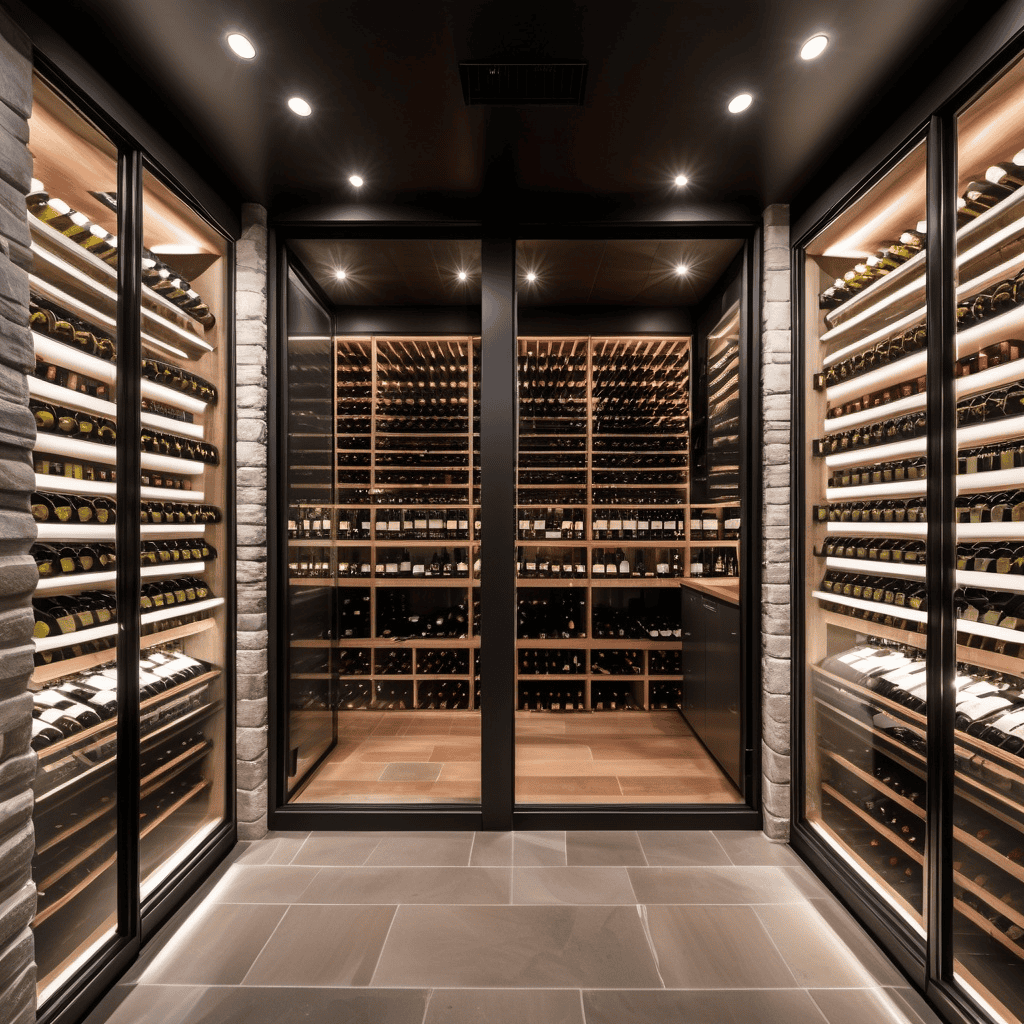
Storage Duration: Timing the Perfect Age
Timing the perfect moment to open an aging wine is more art than science, and believe me, I’ve had my share of “oops, too late” moments.
One of my biggest heartbreaks was waiting too long to open a 1982 Bordeaux, only to find it had passed its peak. These days, I follow a more structured approach to aging windows. Most everyday wines aren’t meant for long-term aging – in fact, about 90% of all wines should be consumed within five years of release.
For those special bottles meant for aging, I keep detailed notes on drinking windows. Red Bordeaux typically peaks between 15-20 years, while most white Burgundies show their best between 7-10 years. I’ve learned to look for signs of maturity: Softening tannins, developing bouquet, and integration of flavors.
Pro Tip: When in doubt, it’s better to open a bottle slightly young than past its prime.
Wine Selection: Choosing Age-Worthy Bottles
Selecting wines for aging is like picking stocks for a long-term investment portfolio – you need to know what you’re looking for.
I’ve made plenty of mistakes here, like trying to age a $15 Merlot (spoiler alert: it didn’t end well). Age-worthy wines typically share certain characteristics: High acidity, good tannin structure, and proper balance of alcohol and fruit. Cabernet Sauvignon, Nebbiolo, and Syrah are usually safe bets, while most Pinot Noirs are better enjoyed young.
I look for wines from reputable producers in good vintages – getting to know vintage charts has saved me from many potential disappointments. The price point usually starts around $30-40 for age-worthy wines, though there are always exceptions.
Remember, aging doesn’t make a bad wine good; it makes a good wine better.
Cellar Organization: Maximizing Storage Efficiency
Organization wasn’t my strong suit when I started collecting – I once spent three hours looking for a specific bottle in my “system” (aka chaos).
Now, I swear by a methodical approach to cellar organization. I use a combination of physical bin locations and digital inventory tracking through a wine app. Every bottle gets logged with its location, purchase date, drinking window, and any special notes.
I organize my cellar by regions and vintages, with special sections for ready-to-drink wines and long-term aging candidates. Regular inventory checks help prevent any surprises, and I rotate bottles periodically to ensure even exposure to any minimal temperature variations.
Table: Cellar Organization – Maximizing Storage Efficiency
| Aspect | Challenges | Solution/Approach | Benefits |
|---|---|---|---|
| Initial State | Chaos and disorganization | Adopt a methodical approach combining physical and digital tracking | Saves time and reduces frustration |
| Tracking | Difficulty locating bottles | Use a wine app to log bottle location, purchase date, drinking window, and special notes | Easy access to detailed bottle information |
| Organization Method | Random bottle placement | Group wines by region, vintage, and purpose (ready-to-drink vs. aging) | Streamlined and logical arrangement |
| Maintenance | Forgetting inventory or losing track | Conduct regular inventory checks and rotate bottles periodically | Prevents surprises and ensures even exposure |
| Customization | System not tailored to personal needs | Create a system that matches collection size and drinking habits | Efficient use of space and personalized system |
Regular Maintenance: Ensuring Long-term Success
If there’s one thing I’ve learned about wine collecting, it’s that maintenance isn’t optional – it’s essential.
I schedule monthly inspections of my entire cellar, checking for leaks, temperature fluctuations, humidity levels, and any signs of bottle deterioration. I keep a maintenance log that tracks everything from filter changes to equipment servicing dates.
Emergency preparedness is crucial, too – I learned this during a power outage that threatened my entire collection. Now, I have a backup power system for my cooling unit and remote monitoring that alerts me to any issues. Regular cleaning is important, but I avoid any strong-smelling products that might affect the wines.
The effort you put into maintenance directly affects the quality of your aged wines – it’s as simple as that.
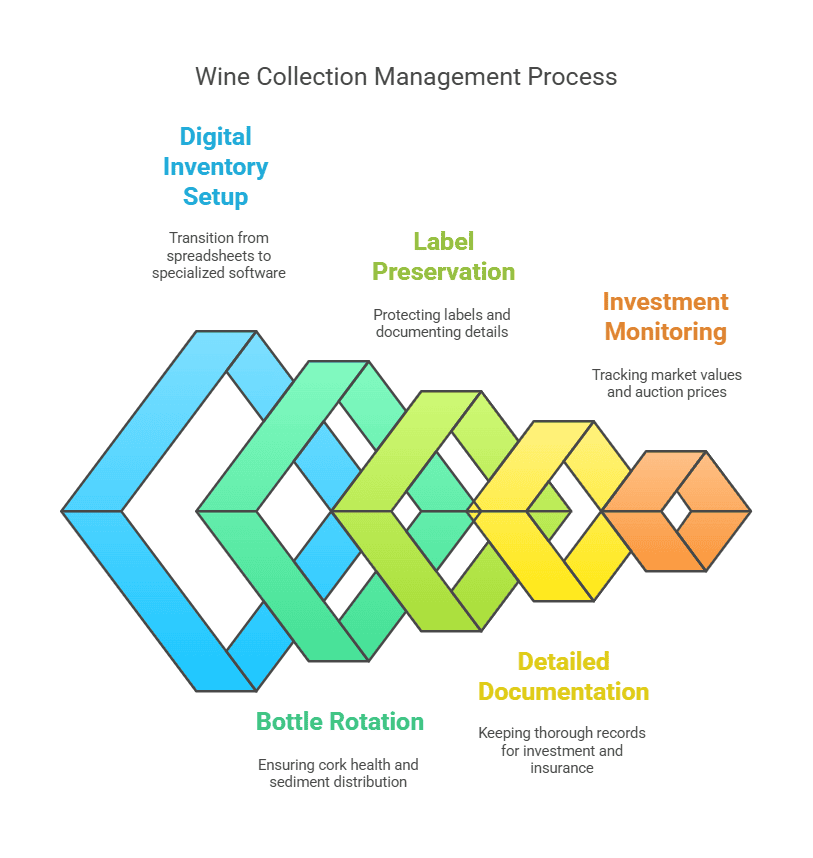
FAQ – Wine Aging Factors
- How long should I age my wine? Answer: It depends on the wine type, but generally, fine red wines can age 10-20 years, while most white wines are best consumed within 2-3 years of release.
- What temperature is ideal for aging wine? Answer: The optimal temperature for aging wine is between 55-57°F (12-14°C), with minimal fluctuation.
- Can I age wine in my regular refrigerator? Answer: No, regular refrigerators are too cold (around 40°F/4°C) and lack proper humidity control, making them unsuitable for wine aging.
- How do I know if a wine is age-worthy? Answer: Age-worthy wines typically have high tannins, good acidity, proper balance, and come from reputable producers. Varieties like Cabernet Sauvignon, Nebbiolo, and vintage Port are particularly suitable.
- What happens if wine is stored at the wrong temperature? Answer: Improper temperature can speed up or slow down the aging process, leading to premature aging, flat flavors, or cork damage. Extreme heat can “cook” the wine, ruining it permanently.
- Should all wines be stored on their side? Answer: Corked wines should be stored on their side to keep the cork moist and prevent oxidation. However, screw-cap bottles can be stored upright.
- How important is humidity in wine storage? Answer: Very important – ideal humidity should be between 60-75%. Too low humidity can dry out corks, while too high humidity can damage labels and promote mold growth.
- Can light really damage wine? Answer: Yes, UV rays can cause a reaction called “light strike,” which can degrade and prematurely age wine, creating off-flavors. This is why wine bottles are often dark-colored.
- Why is vibration bad for aging wine? Answer: Vibration can disturb sediment, disrupt the aging process, and potentially speed up chemical reactions, affecting the wine’s development and final character.
- How do I start a wine collection for aging? Answer: Begin with age-worthy wines from good vintages, invest in proper storage conditions, keep detailed records, and be patient. Consider starting with well-regarded producers and regions known for age-worthy wines.
- What are the signs of a properly aged wine? Answer: A properly aged wine shows integration of flavors, softened tannins, complex aromas, and maintained fruit characteristics, along with secondary and tertiary flavor development.
- Can I age wine in my basement? Answer: Maybe – if your basement maintains consistent temperature and humidity levels, has proper ventilation, and can be protected from light and vibration. However, professional storage solutions are more reliable.
- How do I track my wine’s aging progress? Answer: Keep detailed records of purchase dates, drinking windows, and regular tasting notes. Some collectors buy multiple bottles to taste periodically throughout the aging process.
- What’s the biggest mistake people make when aging wine? Answer: The most common mistake is aging wines that aren’t meant for aging or failing to maintain proper storage conditions consistently throughout the aging period.
- How can I tell if my aged wine has gone bad? Answer: Signs include brown coloration, vinegar-like smell, bubbles in still wine, dried-out cork, wine seepage, and off-putting aromas like wet cardboard (cork taint) or rotten eggs.
Conclusion
Mastering the art of wine aging requires attention to multiple factors, but the rewards of perfectly aged wine make it worthwhile.
By following these essential guidelines, you’ll be well-equipped to create optimal aging conditions for your collection. Remember, successful wine aging is a journey of patience and precision – start implementing these factors today to enjoy exceptional wines tomorrow!
Good luck, and enjoy your wine collection, Cheers!
For your reference, the latest articles by Didi Somm include:
- Best Wine Fridge Temperature Settings: All You Need To Know
- Built-in Wine Refrigerators: All You Need To Know
- Compact Wine Fridges: Best Advice For You
- How To Organize Wine Fridge: Expert Guide 2025
- Best Wine Refrigerators For Every Budget: Expert Guide
- Insights on Long-term Wine Storage: Your Best Expert Guide
Important Notice: The information in this article is for general and public information purposes only. It solely reflects Didi Somm’s or his Staff’s opinion, and no responsibility can be assumed for errors or omissions in the service’s contents. For details, please check the Disclaimer at the bottom of the homepage.

